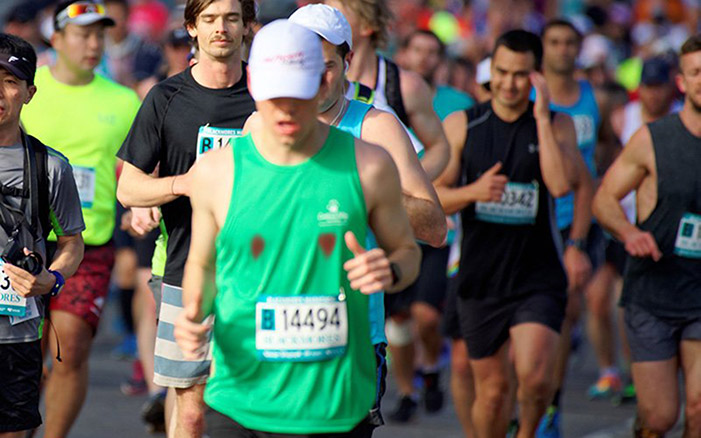You don’t feel it until it’s too late. You cross the finish line, glance down, and your shirt is streaked with blood. Not from a fall—just two raw patches where your nipples used to be.
That’s runner’s nipple. It sneaks up during long runs and races, ruins race photos, and makes showering afterward feel like punishment. But it’s treatable—and preventable. Here’s how to fix it fast and keep it from coming back.
What is runner’s nipple?
Runner’s nipple is a form of friction chafing—usually caused by skin rubbing against a shirt during repetitive motion. The nipple is especially vulnerable because the skin is thinner and more sensitive than most other parts of your body. Even a soft cotton shirt can become abrasive when soaked with sweat over the course of several miles.
It can show up as mild soreness or tingling during the run, then develop into raw skin, scabbing, or even bleeding afterward. The longer you're out there—and the more you sweat or your shirt shifts—the worse it can get. Heat, high humidity, rain, or wind can also increase sensitivity and make damage more likely.

While it's more commonly associated with male runners—thanks to friction against a shirt without the added protection of a sports bra—plenty of women experience it too, especially during long runs or races when the bra or sports top doesn’t sit flush against the skin.
It’s not dangerous, but it’s definitely painful, and if left untreated, it can get bad enough to force you off your training plan. That’s why it’s worth treating right away and learning how to avoid it next time.
How to treat runner’s nipple
If the damage is already done, the goal is to protect the skin, avoid further friction, and help it heal. Treat it like any other running-related injury.
Here’s how to handle it in 5 easy steps:
- Clean the area gently. Use warm water and mild soap—no scrubbing. Pat dry with a clean towel.
- Apply a healing ointment. Runners often use Aquaphor, petroleum jelly, or antibiotic ointment like Neosporin. Antibiotic ointments can help prevent infection if the skin is broken, but they aren’t always necessary—and some people may experience irritation or allergic reactions. If you’ve never used one before, patch test first or stick with plain petroleum jelly.
- Cover the area with a non-stick bandage. Hydrocolloid bandages (like Compeed or Band-Aid Advanced Healing) are great because they stay put and reduce rubbing.
- Wear soft, seamless fabrics. During healing, avoid rough or textured shirts.
- Keep it moisturized, but not soggy. Too much ointment under a bandage can lead to maceration (over-softened skin), so apply a thin layer.
How long does it take to heal?
For most runners, mild cases of nipple chafing heal within 2 to 5 days. If it’s just surface-level redness or rawness, consistent care—gentle cleaning and barrier ointment—usually gets the job done quickly.
If the skin is cracked or scabbing, it may take closer to a full week or more to fully recover. And if you start running again too soon without skin protection, you risk reopening the wound and restarting the healing process. This is one of those injuries where giving it proper time to settle saves more time in the long run.
Can you run while it’s healing?
You can—but it’s not ideal. If the skin is broken, every mile risks irritating the area again. That said, if you're mid-training cycle or just can't skip your workout, protect the area carefully before heading out.
Apply a generous layer of anti-chafing balm like Body Glide, cover with a waterproof bandage, and wear a tight, technical shirt that won’t shift around.
How to prevent it in the future
Once you've experienced runner’s nipple, you’ll never want to deal with it again. Prevention takes less than a minute before your run—and it’s 100% worth the effort.
Here’s what experienced distance runners recommend:
- Lube up before every long run. Use anti-chafe balm (petroleum jelly, lanolin, or a colorless, unscented lip balm all work). Don’t just swipe—really coat the area.
- Cover up. Use band-aids, silicone nipple covers (like NipEaze), or medical-grade tape to create a friction barrier. Some ultra runners use KT tape or RockTape too. Test it first on clean, healed skin to avoid irritation from the adhesive.
- Avoid cotton. Choose snug-fitting, synthetic or wool-blend shirts that wick moisture. Many runners switch to compression tops for long runs to reduce movement.
- Dress for the weather. For rainy or humid runs, apply extra balm. For cold and windy runs, use warmer layers to avoid chafing through stiff fabric.
- Test race gear in advance. Don’t debut a new shirt or bra on race day. Even small seams can rub at mile 20. Ultra runners sometimes sleep in their race shirts to test how the fabric behaves over time—take a cue from that.
Related: Avoid These 5 Sneaky Gear Mistakes on Race Day
Runner’s nipple is one of those things you don’t think about—until it happens. It might be a small patch of skin, but it can wreck a big race day. And if you don’t want to suffer mid-run—or wonder why your race photos look like a horror movie poster—lube up!









